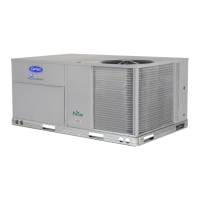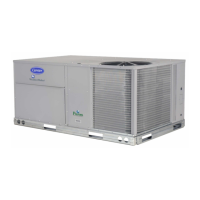124
compressor on the circuit is shut down, at which time the circuit
will be shut down with alert (T120, T121).
This failure follows a 3-strike methodology. When the circuit is
shut down entirely, an alert (T120, T121) is generated and a
strike is logged on the circuit. The Alert and strikes logged will
automatically reset if the saturated suction temperature remains
above 29.4°F for 15 minutes. On the third strike, alarm (A120,
A121) will be generated, which will necessitate a manual reset
to get the circuit back running. It is important to note that a
strike is called out only if all compressors in the circuit are off
at the time of alert.
To prevent nuisance alerts, P120 and P121 show up in the alarm
history and locally at the display, but are never broadcast to the
network. To recover from these pre-alerts, both a 15-minute
hold-off timer and saturated suction temperature rising above
29.4°F must occur. If recovery occurs, staging will be allowed
on the circuit once again. A strike is tied to the circuit going off
entirely, not reducing capacity and recovering. Therefore it is
possible that multiple P120 and P121 alerts may be stored in
alarm history but not broadcast.
T122 (Circuit A High Saturated Suction Temperature)
T123 (Circuit B High Saturated Suction Temperature)
This alert is for display purposes only. No action is taken by
the control when the alert occurs.
When Temperatures
REF.T
SST.A or Temperatures
REF.T
SST.B is greater than 70°F for Configuration
COOL
H.SST minutes, local alert T122 or T123 will occur.
The alerts automatically reset when the corresponding saturat-
ed suction temperature drops below 70°F.
P126 (Circuit A High Head Pressure, Comp Shutdown)
T126 (Circuit A High Head Pressure Alert)
A126 (Circuit A High Head Pressure Alarm)
P127 (Circuit B High Head Pressure, Comp Shutdown)
T127 (Circuit B High Head Pressure Alert)
A127 (Circuit B High Head Pressure Alarm)
This alert/alarm is used to keep the saturated condensing tem-
perature below the compressor operating envelope outlined in
Fig. 18. This alert/alarm also attempts to prevent the saturated
condensing temperature from reaching the high pressure
switch trip point by reducing the upper horizontal portion of
the compressor operating envelope to a level slightly below the
saturated condensing temperature recorded upon a high pres-
sure switch trip (T057, T058).
When Temperatures
REF.T
SCT.A or Temperatures
REF.T
SCT.B rise above the compressor operating envelope
for the corresponding Temperatures
REF.T
SST.A or Tem-
peratures
REF.T
SST.B, a compressor of the affected cir-
cuit will be immediately shut down with pre-alert (P126, P127)
and a 10-minute timeguard will be added to the compressor. If
the saturated condensing temperature remains above the enve-
lope for 5 more seconds, another compressor of the affected
circuit, if it exists, will be shut down with pre-alert (P126,
P127) and a 10-minute timeguard will be added to the com-
pressor. This sequence will continue until the last compressor
on the circuit is shut down, at which time the circuit will be
shut down with alert (T126, T127).
This failure follows a 3 strike methodology. When the circuit is
shut down entirely, an alert (T126, T127) is generated and a
strike is logged on the circuit. On the third strike, alarm (A126,
A127) will be generated which will necessitate a manual reset
to get the circuit back running. It is important to note that a
strike is called out only if all compressors in the circuit are off
at the time of the alert.
To prevent nuisance alerts, P126 and P127 show up in the alarm
history and locally at the display, but are never broadcast to the
network. To recover from these alerts, both a 10-minute hold-off
timer and saturated condensing temperature returning under the
compressor envelope must occur. If recovery occurs, staging will
be allowed on the circuit once again. Again, a strike is tied to the
circuit going off entirely, not reducing capacity and recovering.
Therefore it is possible that multiple P126 and P127 alerts may be
stored in alarm history but not broadcast.
T128 (Digital Scroll High Discharge Temperature Alert)
A128 (Digital Scroll High Discharge Temperature Alarm)
This alert/alarm is for units with a digital scroll compressor only.
The digital scroll compressor is equipped with a temperature
thermistor that is attached to the discharge line of the compressor.
The alert occurs when the discharge temperature thermistor has
measured a temperature above 268°F or the thermistor is short
circuited. The digital scroll compressor will be shut down and
alert T128 will be generated. The compressor will be allowed
to restart after a 30-minute delay and after the thermistor tem-
perature is below 250°F.
If five high discharge temperature alerts have occurred within
four hours, alarm A128 will be generated which will necessi-
tate a manual reset to start the compressor.
A140 (Reverse Rotation Detected)
This alarm performs a check for correct compressor rotation
upon power up of the unit. The method for detecting correct ro-
tation is based on the assumption that there will be a drop in
suction pressure upon a compressor start if the compressor is
rotating in the correct direction.
A test is made once, on power up, for suction pressure change
on the first compressor of the first circuit to start.
Reverse rotation is determined by measuring suction pressure
at 3 points in time:
• 5 seconds prior to compressor start.
• At the instant the compressor starts.
• 5 seconds after the compressor starts.
The rate of suction pressure change from 5 seconds prior to
compressor start to compressor start (rate prior) is compared to
the rate of suction pressure change from compressor start to 5
seconds after compressor start (rate after).
If (rate after) is less than (rate prior minus 1.25), alarm A140 is
generated. This alarm will disable mechanical cooling and will
require a manual reset. This alarm may be disabled once the re-
verse rotation check has been verified by setting Configura-
tion
COOL
RR.VF = Yes.
It is important to note that in Service Test mode, reverse rota-
tion is checked on every compressor start.
A150 (Unit is in Emergency Stop)
If the CCN point name “EMSTOP” in the System table is set to
emergency stop, the unit will shut down immediately and broad-
cast an alarm back to the CCN indicating that the unit is down.
This alarm will clear when the variable is set back to “enable”.
A152 (Unit Down Due to Failure)
This alarm occurs whenever both cooling circuits are unavail-
able to cool. Mechanical cooling is impossible due to a failure
in the system explained through other current alarms.
Possible problems are:
• plenum pressure switch trips on a return fan tracking unit
• the supply fan status alarms have been instructed to shut
down the unit
• both circuits incapable of cooling due to multiple alerts of
compressors and/or pressure alerts
• a hardware failure of the main board's analog to digital
converter or EEPROM chip
• a critical storage failure in EEPROM has rendered the unit
inoperable
• the unit is configured for inlet guide vanes and the actuator
controlling the vanes is in fault.
Reset is automatic.

